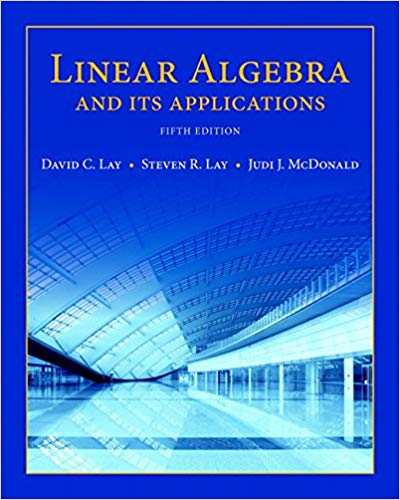
Linear Algebra and Its Applications, 5th Edition
Authors: David C. Lay, Steven R. Lay, Judi J. McDonald
ISBN-13: 978-0321982384
We have solutions for your book!
See our solution for Question 27E from Chapter 2.9 from Lay's Linear Algebra and Its Applications, 5th Edition.
Problem 27E
Chapter:
Problem:
0
Step-by-Step Solution
Given Information
We are given with the bases; $B = \left\{ b _ { 1 } , \ldots , b _ { p } \right\}$ for the subspace $W$ and $L$. And the set $A = \left\{ a _ { 1 } , \ldots , a _ { q } \right\}$ contains more than $p$ vectors. We have to answer some questions based on this information.
Step-1: (a)
We have to explain why for each vector $\mathbf { a } _ { j } ,$ there exists a vector $\mathbf { c } _ { j }$ in $\mathbb { R } ^ { p }$ such that $\mathbf { a } _ { j } = B \mathbf { c } _ { j }$ .
Since B is the basis for the subspace $W = \mathbb { R } ^ { p }$, hence for any vector in W, there exists nonzero constants such that: \[\left[ a _ { j } \right] _ { B } = c _ { 1 } a _ { 1 } + c _ { 2 } a _ { 2 } + \cdots + c _ { p } a _ { p }\]Thus, \[a _ { j } = \sum _ { i = 1 } ^ { p } c _ { i } a _ { i }\]or \[a _ { j } = B c _ { i }\]
Step-2: (b)
If $C = \left[ \mathbf { c } _ { 1 } \cdots \mathbf { c } _ { q } \right] .$, we have to explain why there is a nonzero vector $\mathbf { u }$ such that $C \mathbf { u } = \mathbf { 0 }$ .
The set C contains more vectors then the basis B. Hence C is a linearly dependent set. Thus, the equation $Cu=0$ must have a non-trivial solution.
Step-3: (c)
Using the sets B and C, we have to show that $Au = 0$
The matrix A is given by:\[A = \left[ a _ { 1 } , \ldots , a _ { q } \right] = \left[ B c _ { 1 } , \ldots , B c _ { q } \right] = B C\]Thus, \[\begin{array}{l}Au = BCu\\Au = B(Cu)\\Au = B{\bf{0}}\\Au = {\bf{0}}\end{array}\]Therefore,
The columns of A are linearly independent.
We are given with the bases; $B = \left\{ b _ { 1 } , \ldots , b _ { p } \right\}$ for the subspace $W$ and $L$. And the set $A = \left\{ a _ { 1 } , \ldots , a _ { q } \right\}$ contains more than $p$ vectors. We have to answer some questions based on this information.
Step-1: (a)
We have to explain why for each vector $\mathbf { a } _ { j } ,$ there exists a vector $\mathbf { c } _ { j }$ in $\mathbb { R } ^ { p }$ such that $\mathbf { a } _ { j } = B \mathbf { c } _ { j }$ .
Since B is the basis for the subspace $W = \mathbb { R } ^ { p }$, hence for any vector in W, there exists nonzero constants such that: \[\left[ a _ { j } \right] _ { B } = c _ { 1 } a _ { 1 } + c _ { 2 } a _ { 2 } + \cdots + c _ { p } a _ { p }\]Thus, \[a _ { j } = \sum _ { i = 1 } ^ { p } c _ { i } a _ { i }\]or \[a _ { j } = B c _ { i }\]
Step-2: (b)
If $C = \left[ \mathbf { c } _ { 1 } \cdots \mathbf { c } _ { q } \right] .$, we have to explain why there is a nonzero vector $\mathbf { u }$ such that $C \mathbf { u } = \mathbf { 0 }$ .
The set C contains more vectors then the basis B. Hence C is a linearly dependent set. Thus, the equation $Cu=0$ must have a non-trivial solution.
Step-3: (c)
Using the sets B and C, we have to show that $Au = 0$
The matrix A is given by:\[A = \left[ a _ { 1 } , \ldots , a _ { q } \right] = \left[ B c _ { 1 } , \ldots , B c _ { q } \right] = B C\]Thus, \[\begin{array}{l}Au = BCu\\Au = B(Cu)\\Au = B{\bf{0}}\\Au = {\bf{0}}\end{array}\]Therefore,
The columns of A are linearly independent.